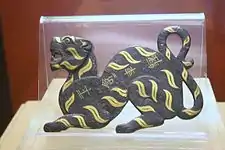Fu (tally)
In ancient China a fu (Chinese: 符; pinyin: ![]() fú) was a tally, made of bamboo, wood, metal (gold, silver, bronze) or jade and used as a proof of authorization.[1] Most commonly, fu were made of wood or bamboo in sizes of wooden slips or bamboo chopsticks.[1] Although fu have been made in various shapes (such as tiger, dragon, turtle, snake, fish or human), most of them come in the shape of a tiger.[1]
fú) was a tally, made of bamboo, wood, metal (gold, silver, bronze) or jade and used as a proof of authorization.[1] Most commonly, fu were made of wood or bamboo in sizes of wooden slips or bamboo chopsticks.[1] Although fu have been made in various shapes (such as tiger, dragon, turtle, snake, fish or human), most of them come in the shape of a tiger.[1]

Classical description of tallies is found in the Zhou li, which refers to the tallies of jade and horn, and mentions the shapes of tiger, human, dragon, seal, and banner.[2]
Fu (surname 符) was derived from the post of title of an official in charge of the tally.[3]
Hu-fu
The two-piece tiger tallies (hu-fu, 虎符 in Chinese) were used by a king or emperor to command and dispatch the army. The right piece was retained in the central government while the left piece was issued to the local officials or commanders. If someone wanted to dispatch the troops from a certain area, he had to show the right piece of the tiger tally in order to obtain authorization; both pieces of the tally had to match each other.[4] The word hu-fu first appears in the biography of Hsin-ling in the Records of the Grand Historian, which tells the story of the stealing of a tiger tally to relieve the state of Zhao.[5] During the Warring States period this kind of fu was changed from jade to bronze.[5]
The tiger tally from the tomb of King Zhao Mo 趙眜 (Nanyue, Western Han), was cast as a single piece. It demonstrates that hu-fu were not uniform and might function not as tallies, but rather as tokens.[6]
The image penetrated popular culture: in The Legend of Qin (animated TV series) animated series tiger tallies are figuratively called "the spirit of Chu troops" (Season 4, episode 16).
References
- "Tally(符 Fu)". China Info Online. Archived from the original on 24 April 2012. Retrieved 28 Sep 2011.
- Lothar von Falkenhausen, "The E Jun Qi Metal Tallies" in Text and Ritual in Early China, 2005:83
- Patrick Hanks, Peter McClure, and Richard Coates. The Oxford Dictionary of Family Names in Britain and Ireland.CS1 maint: multiple names: authors list (link)
- "Tiger Tally". China Ancient. Retrieved 28 Sep 2011.
- Needham, Joseph (1981). Science in traditional China: a comparative perspective. Chinese University Press. p. 97. ISBN 962-201-212-4.
- Lothar von Falkenhausen, "The E Jun Qi Metal Tallies" in Text and Ritual in Early China, 2005:87